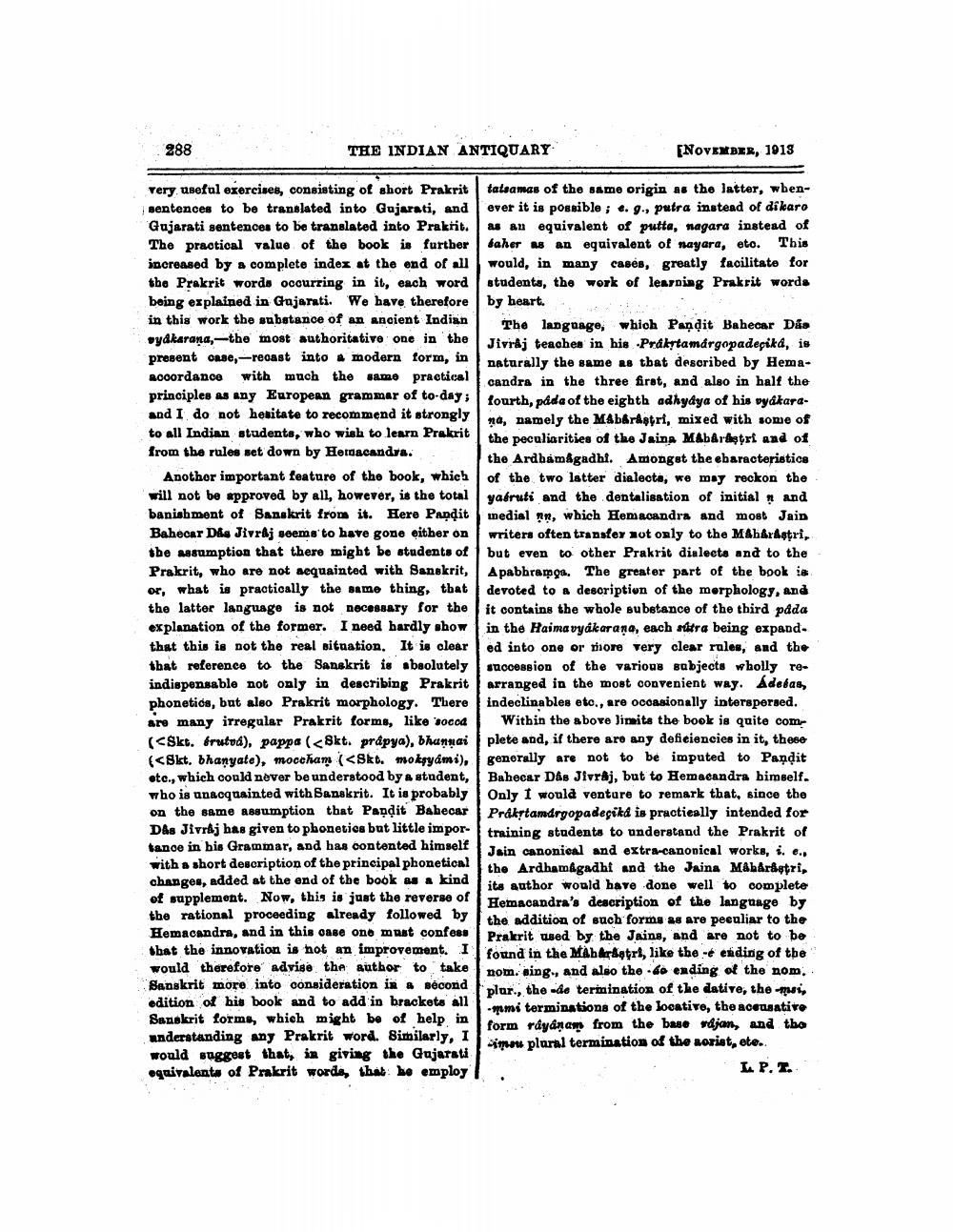________________
288
THE INDIAN ANTIQUARY
[NOVEMBER, 1913
very useful exercises, consisting of short Prakrit tatsamas of the same origin as the latter, whensentences to be translated into Gujarati, and ever it is possible; c. 9., putra instead of dikaro Gujarati sentences to be translated into Prakrit. as an equivalent of putta, nagara instead of The practioal value of the book is further daher as an equivalent of nayara, eto. This increased by a complete index at the end of all would, in many cases, greatly facilitate for the Prakrit words occurring in it, each word students, the work of learning Prakrit words being explained in Gajarati. We have therefore by heart. in this work the substance of an ancient Indian The language, which Pandit Bahecar Das oydkarana,--the most authoritative one in the
Jivraj teaches in his Prákytamargopadeçika, is present case, --recast into a modern form, in
naturally the same as that described by Hemaaccordance with much the same praetical
candra in the three first, and also in half the principles as any European grammar of to-day;
fourth, pada of the eighth adhyaya of his vyákaraand I do not hesitate to recommend it strongly
ņa, namely the Mabáráatri, mixed with some of to all Indian students, who wish to learn Prakrit
the peculiarities of the Jaina MabArdetri and of from the rules set down by Herdacandya..
the Ardbámågadh. Amongst the ebaracteristics Another important feature of the book, which of the two latter dialects, we may reckon the will not be approved by all, however, is the total yafruti and the dentalisation of initial and banishment of Sanskrit from it. Here Pandit medial rn, which Hemacandra and most Jain Bahecer Das Jivr&j seems to have gone either on writers often transfer not only to the M&hárdøtri, the assumption that there might be students of but even to other Prakrit dialects and to the Prakrit, who are not acquainted with Sanskrit, Apabhrama. The greater part of the book is or, what is practically the same thing, that devoted to a description of the morphology, and the latter language is not necessary for the it contains the whole substance of the third pada explanation of the former. I need hardly show in the Haimavyákarana, each sutra being expand. that this is not the real situation. It is clear ed into one or more very clear rules, and the that reference to the Sanskrit is absolutely 1000ession of the various sabjects wholly reindispensable not only in describing Prakrit arranged in the most convenient way. Adelas, phonetics, but also Prakrit morphology. There indeclinables etc., are occasionally interspersed. are many irregular Prakrit forms, like 'rocod Within the above limits the book is quite com (CSkt. frutvá), pappa (<8kt. prapya), bhunnai plete and, if there are any deficiencies in it, these (<Skt. bhanyate), moccham (<Skt. mokyami), genorally are not to be imputed to Pandit etc., which could never be understood by a student, Bahecar Das Jivraj, but to Hemacandra bimself. who is unacquainted with Sanskrit. It is probably Only I would venture to remark that. since the on the same assumption that Pandit Babecar Prakrtamdrgopadeçökd is practically intended for Das Jivraj has given to phonetics but little impor
tle impor. training students to understand the Prakrit of tance in his Grammar, and has contented himself
Jain canonical and extra-canonical works, i. e., with a short description of the principal phonetical
the Ardhamagadht and the Jaina Måbårdstri, changes, added at the end of the book as a kind
its author would have done well to complete of supplement. Now, this is just the reverse of Hemacandra's description of the language by the rational proceeding already followed by the addition of such forms as are peculiar to the Hemacandra, and in this case one must confess
Prakrit used by the Jains, and are not to be that the innovation is not an improvement. I found in the MA retrl, like the - esiding of the vould therefore advise the author to take nom. sing., and also the lo ending of the nom.. Sanskrit more into consideration is a second plur.. the odo termination of the dative, the-msi edition of his book and to add in brackets all
mi terminations of the locative, the acousative Sanskrit forms, which might be of help in
form ráyanam from the baserdjan, and tho understanding any Prakrit word. Similarly, I
imou ploral termination of the aorist, ste.. would suggest that, in giving the Gujarati equivalents of Prakrit words, that he employ I
LP.I.




